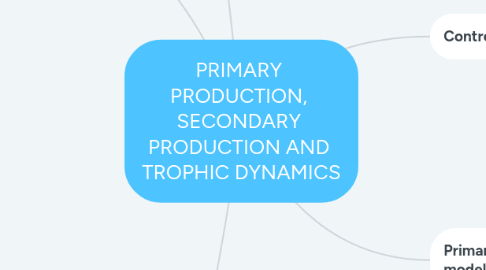
1. Principles and mechanisms
1.1. Secondary Production (Refer to the productivity of consumers)
1.1.1. Herbivores
1.1.2. Carnivores
1.1.3. Decomposers
1.2. The productivity of consumers depend on primary production for energy
1.3. Of the energy assimilated, some goes to production (growth) and much goes to maintenance (respiration)
1.4. For production, we can measure the weight of an organism before and after a meal to get its increase in weight
2. Secondary production and trophic dynamics in ecosystem models
2.1. Trophic-level transfer efficiency can be broken down into 3 ecological efficiency: consumption efficiency, assimilation efficiency and production efficiency.
2.2. Consumption Efficiency
2.2.1. The proportion of production at one trophic level (Prodn-1) that is eaten by, or ingested, by the next trophic level (In)
2.2.2. In terrestrial forests, much allocation is to wood, which is largely unconsumed by herbivores 🡪 consumption efficiency range from 1–2%
2.2.3. In grassland, most plants are non-woody 🡪 consumption efficiency range from 30–60%
2.2.4. In aquatic ecosystem, most plants and algal biomass can be consumed by herbivores 🡪 consumption efficiency from 60-99%
2.2.5. Consumption efficiency of carnivores are higher than herbivores and vary from 5–100%
2.3. Assimilation Efficiency
2.3.1. The proportion of ingested energy that is assimilated into bloodstream (An)
2.3.2. Depends on the quality of food eaten and physiological efficiency of consumers
2.3.3. Carnivores assimilation efficiency are often about 80% because carnivores consume largely soft tissue which is easily assimilated into bloodstream
2.4. Production efficiency
2.4.1. The percentage of energy assimilated by an organism that becomes incorporated into new biomass
2.4.2. Influenced largely by animal metabolism
2.4.3. Trophic level transfer efficiency, the amount of energy at one trophic level that is acquired by the trophic level above and incorporated into biomass, averages about 10%.
3. Food webs and ecosystem processes
3.1. Food Chain -A simple feeding relationships between organisms -Each feeding level in the food chain is called trophic level
3.2. Autotrophs
3.2.1. Form the base of the food chain
3.2.2. Harvest light energy and store energy in carbon compounds include plants, algae and photosynthetic prokaryotes
3.2.3. Not all primary producers utilize sunlight, some organisms (chemoautotrophs) obtain their energy by oxidizing inorganic compounds i.e. sulfides
3.3. Herbivores and Carnivores
3.3.1. Secondary consumers
3.3.2. Feed on tissues of other animals
3.4. Detritivores
3.4.1. Died plants along with animal waste products and remains is called detritus
3.4.2. Consumers that get energy from detritus is called detritivores or decomposers 🡪 breaks down dead organism from all trophic levels
3.4.3. Examples of decomposers are fungi and bacteria
3.5. Connectedness Web
3.5.1. All the known links are drawn and equal importance is attached to each link
3.6. Energy Web
3.6.1. Interaction strength – based on quantities of food consumed and indicated by the thickness of connecting links – were calculated
3.7. Functional Web
3.7.1. Some species are more important than others in food web even if they are not abundant and do not always process a lot of energy ~ keystone species
4. Controls and distribution of NPP
4.1. Ecosystem biomass production is determined by primary production
4.2. Primary production = the production of organic compounds through the process of photosynthesis
4.3. Plants represent the first or primary in trophic level
4.4. Gross primary production (GPP) is used to measure plant production Efficiency of
4.5. Net Primary Production (NPP) is the amount of energy that is available to primary consumers (herbivores).
4.5.1. NPP = GPP – R (energy lost in plant cellular respiration)
